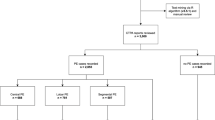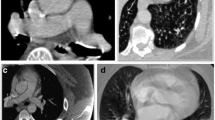Abstract
Purpose
To compare patient outcomes following magnetic resonance angiography (MRA) versus computed tomographic angiography (CTA) ordered for suspected pulmonary embolism (PE).
Methods
In this IRB-approved, single-center, retrospective, case-control study, we reviewed the medical records of all patients evaluated for PE with MRA during a 5-year period along with age- and sex-matched controls evaluated with CTA. Only the first instance of PE evaluation during the study period was included. After application of our exclusion criteria to both study arms, the analysis included 1173 subjects. The primary endpoint was major adverse PE-related event (MAPE), which we defined as major bleeding, venous thromboembolism, or death during the 6 months following the index imaging test (MRA or CTA), obtained through medical record review. Logistic regression, chi-square test for independence, and Fisher’s exact test were used with a p < 0.05 threshold.
Results
The overall 6-month MAPE rate following MRA (5.4%) was lower than following CTA (13.6%, p < 0.01). Amongst outpatients, the MAPE rate was lower for MRA (3.7%) than for CTA (8.0%, p = 0.01). Accounting for age, sex, referral source, BMI, and Wells’ score, patients were less likely to suffer MAPE than those who underwent CTA, with an odds ratio of 0.44 [0.24, 0.80]. Technical success rate did not differ significantly between MRA (92.6%) and CTA (90.5%) groups (p = 0.41).
Conclusion
Within the inherent limitations of a retrospective case-controlled analysis, we observed that the rate of MAPE was lower (more favorable) for patients following pulmonary MRA for the primary evaluation of suspected PE than following CTA.


Similar content being viewed by others
References
Tapson VF (2008) Acute pulmonary embolism. N Engl J Med 358:1037–1052. https://doi.org/10.1056/NEJMra072753
Lilienfeld D, Chan E, Ehland J, Godbold J, Landrigan P, Marsh G (1990) Mortality from pulmonary embolism in the United States: 1962 to 1984. Chest 98:1067–1072. https://doi.org/10.1378/chest.98.5.1067
van Belle A, Büller HR, Huisman MV, Huisman PM, Kaasjager K, Kamphuisen PW, Kramer MH, Kruip MJ, Kwakkel-van Erp J, Leebeek FW, Nijkeuter M, Prins MH, Sohne M, Tick LW, Christopher Study Investigators (2006) Effectiveness of managing suspected pulmonary embolism using an algorithm combining clinical probability, D-dimer testing, and computed tomography. JAMA 295:172–179. https://doi.org/10.1001/jama.295.2.172
Stein PD, Woodard PK, Weg JG, Wakefield TW, Tapson VF, Sostman HD, Sos TA, Quinn DA, Leeper KV Jr, Hull RD, Hales CA, Gottschalk A, Goodman LR, Fowler SE, Buckley JD, PIOPED II Investigators (2007) Diagnostic pathways in acute pulmonary embolism: recommendations of the PIOPED II investigators. Radiology 242:15–21. https://doi.org/10.1148/radiol.2421060971
Brenner DJ, Hall EJ (2007) Computed tomography—an increasing source of radiation exposure. N Engl J Med 357:2277–2284. https://doi.org/10.1056/NEJMra072149
Raja AS, Ip IK, Prevedello LM, Sodickson AD, Farkas C, Zane RD, Hanson R, Goldhaber SZ, Gill RR, Khorasani R (2012) Effect of computerized clinical decision support on the use and yield of CT pulmonary angiography in the emergency department. Radiology 262:468–474. https://doi.org/10.1148/radiol.11110951
Carrier M, Righini M, Wells PS, Perrier A, Anderson DR, RODGER MA et al (2010) Subsegmental pulmonary embolism diagnosed by computed tomography: incidence and clinical implications. A systematic review and meta-analysis of the management outcome studies. J Thromb Haemost 8:1716–1722. https://doi.org/10.1111/j.1538-7836.2010.03938.x
Carrier M, Righini M, Le Gal G (2012) Symptomatic subsegmental pulmonary embolism: what is the next step? J Thromb Haemost 10:1486–1490. https://doi.org/10.1111/j.1538-7836.2012.04804.x
Wiener RS, Schwartz LM, Woloshin S (2011) Time trends in pulmonary embolism in the United States: evidence of overdiagnosis. Arch Intern Med 171:831–837. https://doi.org/10.1001/archinternmed.2011.178
Douglas PS, Taylor A, Bild D, Bonow R, Greenland P, Lauer M, Peacock F, Udelson J (2009) Outcomes research in cardiovascular imaging: report of a workshop sponsored by the National Heart, Lung, and Blood Institute. J Am Soc Echocardiogr 22:766–773. https://doi.org/10.1016/j.echo.2009.05.026
American College of Radiology (2016) ACR manual on contrast media, version 10.2. ACR Committee on Drugs and Contrast Media
Schiebler ML, Holland GA, Hatabu H, Listerud J, Foo T, Palevsky H, Edmunds H, Gefter WB (1993) Suspected pulmonary embolism: prospective evaluation with pulmonary MR angiography. Radiology 189:125–131. https://doi.org/10.1148/radiology.189.1.8372181
Meaney JF, Weg JG, Chenevert TL, Stafford-Johnson D, Hamilton BH, Prince MR (1997) Diagnosis of pulmonary embolism with magnetic resonance angiography. N Engl J Med 336:1422–1427
Kalb B, Sharma P, Tigges S, Ray GL, Kitajima HD, Costello JR, Chen Z, Martin DR (2012) MR imaging of pulmonary embolism: diagnostic accuracy of contrast-enhanced 3D MR pulmonary angiography, contrast-enhanced low-flip angle 3D GRE, and nonenhanced free-induction FISP sequences. Radiology 263:271–278. https://doi.org/10.1148/radiol.12110224
Revel MP, Sanchez O, Couchon S, Planquette B, Hernigou A, Niarra R et al (2012) Diagnostic accuracy of magnetic resonance imaging for an acute pulmonary embolism: results of the “IRM-EP” study. J Thromb Haemost 10:743–750. https://doi.org/10.1111/j.1538-7836.2012.04652.x
Zhang L-J, Luo S, Yeh BM, Zhou CS, Tang CX, Zhao Y et al (2013) Diagnostic accuracy of three-dimensional contrast-enhanced MR angiography at 3-T for acute pulmonary embolism detection: comparison with multidetector CT angiography. Int J Cardiol 168:4775–4783. https://doi.org/10.1016/j.ijcard.2013.07.228
Grist TM, Sostman HD, MacFall JR, Foo TK, Spritzer CE, Witty L, Newman GE, Debatin JF, Tapson V, Saltzman HA (1993) Pulmonary angiography with MR imaging: preliminary clinical experience. Radiology 189:523–530. https://doi.org/10.1148/radiology.189.2.8210385
Stein PD, Chenevert TL, Fowler SE, Goodman LR, Gottschalk A, Hales CA, Hull RD, Jablonski KA, Leeper KV Jr, Naidich DP, Sak DJ, Sostman HD, Tapson VF, Weg JG, Woodard PK, PIOPED III (Prospective Investigation of Pulmonary Embolism Diagnosis III) Investigators (2010) Gadolinium-enhanced magnetic resonance angiography for pulmonary embolism: a multicenter prospective study (PIOPED III). Ann Intern Med 152:434–443, W142–3. https://doi.org/10.1059/0003-4819-152-7-201004060-00008
Nagle SK, Schiebler ML, Repplinger MD, Francois CJ, Vigen KK, Yarlagadda R et al (2016) Contrast enhanced pulmonary magnetic resonance angiography for pulmonary embolism: building a successful program. Eur J Radiol 85:553–563. https://doi.org/10.1016/j.ejrad.2015.12.018
Schiebler ML, Nagle SK, Francois CJ, Repplinger MD, Hamedani AG, Vigen KK et al (2013) Effectiveness of MR angiography for the primary diagnosis of acute pulmonary embolism: clinical outcomes at 3 months and 1 year. J Magn Reson Imaging 38:914–925. https://doi.org/10.1002/jmri.24057
Harris PA, Taylor R, Thielke R, Payne J, Gonzalez N, Conde JG (2009) Research electronic data capture (REDCap)—a metadata-driven methodology and workflow process for providing translational research informatics support. J Biomed Inform 42:377–381. https://doi.org/10.1016/j.jbi.2008.08.010
Wells PS, Anderson DR, Rodger M, Ginsberg JS, Kearon C, Gent M, Turpie AG, Bormanis J, Weitz J, Chamberlain M, Bowie D, Barnes D, Hirsh J (2000) Derivation of a simple clinical model to categorize patients probability of pulmonary embolism: increasing the models utility with the SimpliRED D-dimer. Thromb Haemost 83:416–420
Le Gal G, Righini M, Roy P-M, Sanchez O, Aujesky D, Bounameaux H et al (2006) Prediction of pulmonary embolism in the emergency department: the revised Geneva score. Ann Intern Med 144:165–171
Keeley EC, Velez CA, O'Neill WW, Safian RD (2001) Long-term clinical outcome and predictors of major adverse cardiac events after percutaneous interventions on saphenous vein grafts. J Am Coll Cardiol 38:659–665. https://doi.org/10.1016/S0735-1097(01)01420-6
Schulman S, Kearon C (2005) Subcommittee on control of anticoagulation of the scientific and standardization Committee of the International Society on thrombosis and Haemostasis, definition of major bleeding in clinical investigations of antihemostatic medicinal products in non-surgical patients. J Thromb Haemost 3:692–694. https://doi.org/10.1111/j.1538-7836.2005.01204.x
Brau ACS, Beatty PJ, Skare S, Bammer R (2008) Comparison of reconstruction accuracy and efficiency among autocalibrating data-driven parallel imaging methods. Magn Reson Med 59:382–395. https://doi.org/10.1002/mrm.21481
Lum DP, Busse RF, Francois CJ, Brau AC, Beatty PJ, Huff J, Brittain JH, Reeder SB (2009) Increased volume of coverage for abdominal contrast-enhanced MR angiography with two-dimensional autocalibrating parallel imaging: initial experience at 3.0 Tesla. J Magn Reson Imaging 30:1093–1100. https://doi.org/10.1002/jmri.21964
Schiebler ML, Ahuja J, Repplinger MD, Francois CJ, Vigen KK, Grist TM et al (2016) Incidence of actionable findings on contrast enhanced magnetic resonance angiography ordered for pulmonary embolism evaluation. Eur J Radiol 85:1383–1389. https://doi.org/10.1016/j.ejrad.2016.05.008
Acknowledgements
We are very appreciative of the support of Azita Hamedani, MD, MPH. As chair of the Department of Emergency Medicine, she has provided important input necessary for successful implementation of this clinical program for patients presenting to the Emergency Department. Also, Karl Vigen, PhD has provided MRI medical physics support. Finally, we very much appreciate early discussions on the study design with Alejandro Munoz del Rio, PhD. The University of Wisconsin Department of Radiology also wishes to acknowledge research support from GE Healthcare and Bracco Diagnostics.
Funding
This study received support from the NIH, including the National Center for Advancing Translational Sciences grants UL1 TR000427 and KL2 TR000428 and the National Institute of Diabetes and Digestive and Kidney Diseases grants K08 DK111234 and K24 DK102595. The study also benefited from the University of Wisconsin - Madison’s Department of Radiology Research and Development Fund. None of the funding sources were involved in any component of the conduct, analysis, or reporting of this study.
Author information
Authors and Affiliations
Corresponding author
Ethics declarations
This study was approved by the University of Wisconsin Health Sciences Institutional Review Board and adhered to regulations as outlined in the Health Insurance Portability and Accountability Act.
Conflict of interest
The University of Wisconsin - Madison Department of Radiology receives research support from GE Healthcare and Bracco Diagnostics. Scott B. Reeder, MD, PhD has the following financial disclosures: Co-founder of Calimetrix; shareholder, Cellectar Biosciences and Elucent Medical; consultant for Parexel International. The other authors declare that they have no conflicts of interest.
Electronic supplementary material
ESM 1
(DOCX 45 kb)
Rights and permissions
About this article
Cite this article
Repplinger, M.D., Nagle, S.K., Harringa, J.B. et al. Clinical outcomes after magnetic resonance angiography (MRA) versus computed tomographic angiography (CTA) for pulmonary embolism evaluation. Emerg Radiol 25, 469–477 (2018). https://doi.org/10.1007/s10140-018-1609-8
Received:
Accepted:
Published:
Issue Date:
DOI: https://doi.org/10.1007/s10140-018-1609-8




